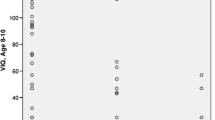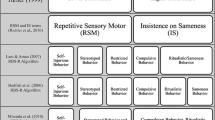Abstract
Prior studies investigating restricted and repetitive behavior (RRB) subtypes within autism spectrum disorder (ASD) have found varied factor structures for symptom groupings, in part, due to variation in symptom measurement and broad sample age ranges. This study examined RRBs among 827 preschool-age children, ages 35 to 71 months, through an exploratory factor analysis of RRB items from the Autism Diagnostic Interview-Revised (ADI-R) collected through the Study to Explore Early Development. The factor structures of RRBs among children with confirmed ASD versus those with non-autism developmental concerns were qualitatively compared. Correlations between RRB factors and participant characteristics were examined in the ASD group. Three conceptually well-defined factors characterized as repetitive sensorimotor behaviors (RSMB), insistence on sameness (IS), and a novel stereotyped speech (SPEECH) factor emerged for the ASD group only. Distinct factors were supported by different clinical correlates. Findings have implications for improving differential diagnosis and understanding of ASD symptomatology in this age range.

Similar content being viewed by others
References
Achenbach, T. M., & Rescorla, L. A. (2000). Manual for the ASEBA Preschool Forms & Profiles. Burlington, VT: University of Vermont, Research Center for Children, Youth, & Families.
American Psychiatric Association. (2013). Diagnostic and statistical manual of mental disorders: DSM-5. Washington, DC: American Psychiatric Association.
Baranek, G. T., Boyd, B., Poe, M. D., David, F. J., & Watson, L. R. (2007). Hyperresponsive sensory patterns in young children with autism, developmental delay, and typical development. American Journal of Mental Retardation, 112, 233–245. https://doi.org/10.1002/aur.124
Barrett, S., Prior, M., & Manjiviona, J. (2004). Children on the borderlands of autism. Autism, 8, 61–87. https://doi.org/10.1177/1362361304040640
Berry, K., Russell, K., & Frost, K. (2018). Restricted and repetitive behaviors in autism spectrum disorder: A review of associated features and presentation across clinical populations. Current Developmental Disorders Reports, 5(2), 108–115. https://doi.org/10.1007/s40474-018-0139-0
Bishop, S. L., Hus, V., Duncan, A., Huerta, M., Gotham, K., Pickles, A., et al. (2013). Subcategories of restricted and repetitive behaviors in children with autism spectrum disorders. Journal of Autism and Developmental Disorders, 43, 1287–1297. https://doi.org/10.1007/s10803-012-1671-0
Bishop, S. L., Richler, J., & Lord, C. (2006). Association between restricted and repetitive behaviors and nonverbal IQ in children with autism spectrum disorders. Child Neuropsychology, 12(4–5), 247–267. https://doi.org/10.1080/09297040600630288
Bodfish, J. W., Symons, F. J., Parker, D. E., & Lewis, M. H. (2000). Varieties of repetitive behavior in autism: Comparisons to mental retardation. Journal of Autism and Developmental Disorders, 30, 237–243. https://doi.org/10.1023/A:1005596502855
Bourreau, Y., Roux, S., Gomot, M., Bonnet-Brilhault, F., & Barthélémy, C. (2009). Validation of the repetitive and restricted behaviour scale in autism spectrum disorders. European Child and Adolescent Psychiatry, 18, 675–682. https://doi.org/10.1007/s00787-009-0028-5
Bruckner, C. T., & Yoder, P. (2007). Restricted object use in young children with autism. Autism, 11, 161–171. https://doi.org/10.1177/1362361307075709
Cuccaro, M. L., Shao, Y., Grubber, J., Slifer, M., Wolpert, C. M., Donnelly, S. L., ... & Pericak-Vance, M. A. (2003). Factor analysis of restricted and repetitive behaviors in autism using the Autism Diagnostic Interview-R. Child Psychiatry and Human Development, 34(1), 3-17. https://doi.org/10.1023/A:1025321707947
Elison, J. T., Wolff, J. J., Reznick, S., Botterton, K. N., Estes, A. M., Gu, H., Hazlett, H., …& Piven, J. (2014). Repetitive behavior in 12-month-olds later classified with autism spectrum disorder. Journal of the American Academy of Child and Adolescent Psychiatry, 53, 1216-1224. doi: 10.1016/j.jaac.2014.08.004
Flores, C. G., Valcante, G., Guter, S., Zaytoun, A., Wray, E., Bell, L., & Kim, S. J. (2011). Repetitive behavior profiles: Consistency across autism spectrum disorder cohorts and divergence from Prader-Willi syndrome. Journal of Neurodevelopmental Disorders, 3, 316–324. https://doi.org/10.1007/s11689-011-9094-3
Georgiades, S., Papageorgiou, V., & Anagnostou, E. (2010). Brief report: Repetitive behaviors in Greek individuals with autism spectrum disorder. Journal of Autism and Developmental Disorders, 40, 903–906. https://doi.org/10.1007/s10803-009-0927-9
Gotham, K., Bishop, S. L., Hus, V., Huerta, M., Lund, S., Buja, A., et al. (2013). Exploring the relationship between anxiety and insistence on sameness in autism spectrum disorders. Autism Research, 6, 33–41. https://doi.org/10.1002/aur.1263
Gray, K. M., Tonge, B. J., & Sweeney, D. J. (2008). Using the autism diagnostic interview-revised and the autism diagnostic observation schedule with young children with developmental delay: Evaluating diagnostic validity. Journal of Autism and Developmental Disorders, 38, 657–667.
Harrop, C., McConachie, H., Emsley, R., Leadbitter, K., Green, J., & PACT Consortium. (2014). Restricted and repetitive behaviors in autism spectrum disorders and typical development: cross-sectional and longitudinal comparisons. Journal of Autism and Developmental Disorders, 44(5), 1207–1219. https://doi.org/10.1007/s10803-013-1986-5
Honey, E., Leekam, S., Turner, M., & McConachie, H. (2007). Repetitive behaviour and play in typically developing children and children with autism spectrum disorders. Journal of Autism and Developmental Disorders, 37, 1107–1115. https://doi.org/10.1007/s10803-006-0253-4
Honey, E., McConachie, H., Randle, V., Shearer, H., & Le Couteur, A. S. (2008). One-year change in repetitive behaviours in young children with communication disorders including autism. Journal of Autism and Developmental Disorders, 38, 1439–1450. https://doi.org/10.1007/s10803-006-0191-1
Hooker, J. L., Dow, D., Morgan, L., Schatschneider, C., & Wetherby, A. M. (2019). Psychometric analysis of the repetitive behavior scale-revised using confirmatory factor analysis in children with autism. Autism Research, 000, 1–12. https://doi.org/10.1002/aur.2159
Joseph, L., Thurm, A., Farmer, C., & Shumway, S. (2013). Repetitive behaviors and restricted interests in young children with autism: Comparison with controls and stability over 2 years. Autism Research, 6, 584–595.
Kim, S., & Lord, C. (2012). New autism diagnostic interview-revised algorithms for toddlers and young preschoolers from 12–47 months of age. Journal of Autism and Developmental Disorders, 42, 82–93. https://doi.org/10.1007/s10803-011-1213-1
Lam, K. S. L., & Aman, M. G. (2007). The repetitive behavior scale-revised: Independent validation in individuals with autism spectrum disorders. Journal of Autism and Developmental Disorders, 37, 855–866. https://doi.org/10.1007/s10803-006-0213-z
Lam, K. S. L., Bodfish, J. W., & Piven, J. (2008). Evidence for three subtypes of repetitive behavior in autism that differ in familiality and association with other symptoms. Journal of Child Psychology and Psychiatry, 49(11), 1193–1200. https://doi.org/10.1111/j.1469-7610.2008.01944.x
Lecavalier L., Aman M. G., Scahill L., McDougle C. J., McCracken J. T., Vitiello B.,…& Kau A. S. (2006). Validity of the autism diagnostic interview-revised. American Journal of Mental Retardation, 111(3), 199-215
Leekam, S. R., Prior, M. R., & Uljarević, M. (2011). Restricted and repetitive behaviors in autism spectrum disorders: A review of research in the last decade. Psychological Bulletin, 137(4), 562–593. https://doi.org/10.1037/a0023341
Leekam, S. R., Tandos, J., McConachie, H., Meins, E., Parkinson, K., Wright, C.,…& Le Couteur, A. (2007). Repetitive behaviours in typically developing 2-year-olds. Journal of Child Psychology and Psychiatry, 48, 1131-1138. https://doi.org/10.1111/j.1469-7610.2007.01778.x
Lidstone, J., Uljarević, M., Sullivan, J., Rodgers, J., McConachie, H., Freeston, M., ... & Leekam, S. (2014). Relations among restricted and repetitive behaviors, anxiety and sensory features in children with autism spectrum disorders. Research in Autism Spectrum Disorders, 8(2), 82-92. https://doi.org/10.1016/j.rasd.2013.10.001
Lord, C., Rutter, M., DiLavore, P. C., & Risi, S. (1999). Autism diagnostic observation schedule (WPS). Los Angeles, CA: Western Psychological Services.
Mahone, E. M., Bridges, D., Prahme, C., & Singer, H. S. (2004). Repetitive arm and hand movements (complex motor stereotypies) in children. The Journal of Pediatrics, 145, 391–395. https://doi.org/10.1016/j.peds.2004.06.014
Matson, J. L., Dempsey, T., & Fodstad, J. C. (2009). Stereotypies and repetitive/restricted behaviours in infants with autism and pervasive developmental disorder. Developmental Neurorehabilitation, 12, 122–127. https://doi.org/10.1080/17518420902936730
Mirenda, P., Smith, I. M., Vaillancourt, T., Georgiades, S., Duku, E., Szatmari, P., ... & Waddell, C. (2010). Validating the repetitive behavior scale-revised in young children with autism spectrum disorder. Journal of Autism and Developmental Disorders, 40, 1521-1530. https://doi.org/10.1007/s10803-010-1012-0
Mooney, E. L., Gray, K. M., Tonge, B. J., Sweeney, D. J., & Taffe, J. R. (2009). Factor analytic study of repetitive behaviours in young children with pervasive developmental disorders. Journal of Autism and Developmental Disorders, 39, 765–774. https://doi.org/10.1007/s10803-008-0680-5
Mullen, E. M. (1995). Mullen scales of early learning (AGS). Circle Pines, MN: American Guidance Service Inc.
Ozonoff, S., Macari, S., Young, G. S., Goldring, S., Thompson, M., & Rogers, S. J. (2008). Atypical object exploration at 12 months of age is associated with autism in a prospective sample. Autism, 12, 457–472. https://doi.org/10.1177/1362361308096402
Richler, J., Bishop, S. L., Kleinke, J. R., & Lord, C. (2007). Restricted and repetitive behaviors in young children with autism spectrum disorders. Journal of Autism and Developmental Disorders, 37, 73–85. https://doi.org/10.1007/s10803-006-0332-6
Richler, J., Huerta, M., Bishop, S. L., & Lord, C. (2010). Developmental trajectories of restricted and repetitive behaviors and interests in children with autism spectrum disorders. Development and Psychopathology, 22(01), 55–69. https://doi.org/10.1017/s0954579409990265
Rutter, M., Bailey, A., & Lord, C. (2003). Social communication questionnaire (SCQ). [Screening Instrument]. Torrance, CA: WPS.
Rutter, M., LeCouter, A., & Lord, C. (2003). Autism diagnostic interview, revised (ADI-R). [Assessment Instrument]. Torrance, CA: WPS.
Schendel, D., DiGuiseppi, C., Croen, L., Fallin, M. D., Reed, P. L., Schieve, L., … Yeargin-Allsopp, M. (2012). The Study to Explore Early Development (SEED): A multisite epidemiologic study of autism by the Centers for Autism and Developmental Disabilities Research and Epidemiology (CADDRE) Network. Journal of Autism and Developmental Disorders, 42, 2121-2140. doi: 10.1007/s10803-012-1461-8
South, M., Ozonoff, S., & McMahon, W. (2005). Repetitive behavior profiles in Asperger syndrome and high-functioning autism. Journal of Autism and Developmental Disorders, 35, 145–158. https://doi.org/10.1007/s10803-004-1992-8
Sparrow, S. S., Cicchetti, D. V., & Balla, D. A. (2005). Vineland adaptive behavior scales, second edition. [Assessment Instrument]. Circle Pines, MN: AGS Publishing.
Szatmari, P., Georgiades, S., Bryson, S., Zwaigenbaum, L., Roberts, W., Mahoney, W., et al. (2006). Investigating the structure of the restricted, repetitive behaviours and interests domain of autism. Journal of Child Psychology and Psychiatry, 47(6), 582–590. https://doi.org/10.1111/j.1469-7610.2005.01537.x
Watt, N., Wetherby, A. M., Barber, A., & Morgan, L. (2008). Repetitive and stereotyped behaviors in children with autism spectrum disorders in the second year of life. Journal of Autism and Developmental Disorders, 38, 1518–1533. https://doi.org/10.1007/s10803-007-0532-8
Wiggins, L. D., Reynolds, A., Rice, C. E., Moody, E., Bernal, P., Blaskey, L., et al. (2015). Using standardized diagnostic instruments to classify children with autism in the Study to Explore Early Development. Journal of Autism and Developmental Disorders, 45, 1271–1280. https://doi.org/10.1007/s10803-014-2287-3
Wiggins, L. D., Robins, D. L., Bakeman, R., & Adamson, L. B. (2009). Brief report: Sensory abnormalities as distinguishing symptoms of autism spectrum disorders in young children. Journal of Autism and Developmental Disorders, 39, 1087–1091. https://doi.org/10.1007/s10803-009-0711-x
Wolff, J. J., Botteron, K. N., Dager, S. R., Elison, J. T., Estes, A. M., Gu, H., ... & Zwaigenbaum, L. (2014). Longitudinal patterns of repetitive behavior in toddlers with autism. Journal of Child Psychology and Psychiatry, 55(8), 945-953. https://doi.org/10.1111/jcpp.12207
Acknowledgement
This research was supported by six cooperative agreements from the Centers for Disease Control and Prevention (Cooperative Agreements Numbers U10DD000180, U10DD000181, U10DD000182, U10DD000183, U10DD000184, and U10DD000498). The findings and conclusions in this manuscript are those of the authors and do not necessarily represent the official position of the Centers for Disease Control and Prevention. This analysis used data from the Study to Explore Early Development (SEED). We gratefully acknowledge the SEED families and staff.
Author information
Authors and Affiliations
Contributions
All named authors approve of being listed as an author on the manuscript, A Distinct Three-Factor Structure of Restricted and Repetitive Behaviors in an Epidemiologically Sound Sample of Preschool-Age Children with Autism Spectrum Disorder. Each author has been directly involved in the conception and design of analyses, analysis and interpretation of data, and/or preparation and revisions to the written manuscript submitted.
Corresponding author
Ethics declarations
Conflict of interest
The authors declare that they have no conflict of interest.
Additional information
Publisher's Note
Springer Nature remains neutral with regard to jurisdictional claims in published maps and institutional affiliations.
Rights and permissions
About this article
Cite this article
Hiruma, L., Pretzel, R.E., Tapia, A.L. et al. A Distinct Three-Factor Structure of Restricted and Repetitive Behaviors in an Epidemiologically Sound Sample of Preschool-Age Children with Autism Spectrum Disorder. J Autism Dev Disord 51, 3456–3468 (2021). https://doi.org/10.1007/s10803-020-04776-x
Accepted:
Published:
Issue Date:
DOI: https://doi.org/10.1007/s10803-020-04776-x




